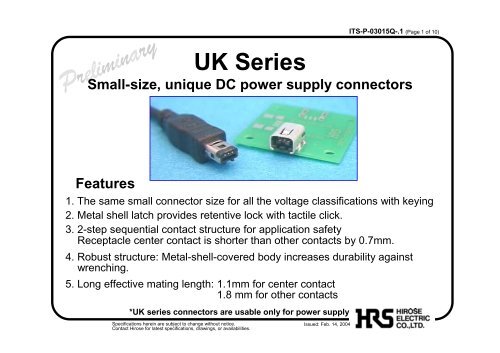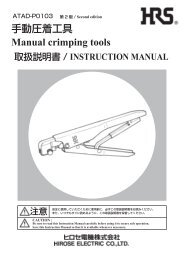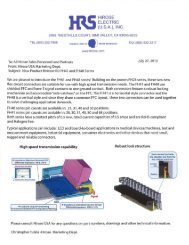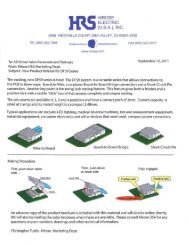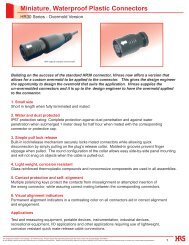UK Series - HIROSE USA
UK Series - HIROSE USA
UK Series - HIROSE USA
You also want an ePaper? Increase the reach of your titles
YUMPU automatically turns print PDFs into web optimized ePapers that Google loves.
ITS-P-03015Q-.1 (Page 1 of 10)<br />
<strong>UK</strong> <strong>Series</strong><br />
Small-size, unique DC power supply connectors<br />
Features<br />
1. The same small connector size for all the voltage classifications with keying<br />
2. Metal shell latch provides retentive lock with tactile click.<br />
3. 2-step sequential contact structure for application safety<br />
Receptacle center contact is shorter than other contacts by 0.7mm.<br />
4. Robust structure: Metal-shell-covered body increases durability against<br />
wrenching.<br />
5. Long effective mating length: 1.1mm for center contact<br />
1.8 mm for other contacts<br />
*<strong>UK</strong> series connectors are usable only for power supply<br />
Specifications herein are subject to change without notice.<br />
Contact Hirose for latest specifications, drawings, or availabilities.<br />
Issued: Feb. 14, 2004
ITS-P-03015Q-.1 (Page 2 of 10)<br />
The Same Small Size for All Classifications with Keying<br />
(From Classification 2 to 5)<br />
Typical DC connectors<br />
Connector size increases for higher voltage classifications.<br />
Hirose <strong>UK</strong> connectors<br />
A distinct key is made for each classification, to realize the same small<br />
size for all classifications. Space saving!<br />
Classification 2<br />
Classification 3<br />
Classification 4<br />
Classification 5<br />
<strong>UK</strong><br />
Receptacle<br />
<strong>UK</strong> Plug<br />
*The key design models above may be changed during the product development process.<br />
Specifications herein are subject to change without notice.<br />
Contact Hirose for latest specifications, drawings, or availabilities.<br />
Issued: Feb. 14, 2004
ITS-P-03015Q (Page 3 of 10)<br />
Size Comparison with Typical DC Connectors<br />
Plug<br />
Receptacle<br />
Voltage<br />
Classification<br />
Typical DC plug<br />
<strong>UK</strong> with<br />
keys<br />
Typical DC jack<br />
<strong>UK</strong> with<br />
keys<br />
Occupied surface<br />
comparison<br />
(<strong>UK</strong> as 100 %)<br />
1<br />
(to 3.15 V)<br />
-<br />
-<br />
93 %<br />
2<br />
(3.15 V to 6.3 V)<br />
128 %<br />
3<br />
(6.3 V to 10.5 V)<br />
202 %<br />
4<br />
(10.5 V to 13.5 V)<br />
254 %<br />
5<br />
(12.5 V to 18.0 V)<br />
278 %
Retentive Lock with Tactile Click<br />
ITS-P-03015Q-.1 (Page 4 of 10)<br />
Typical DC connectors<br />
<strong>UK</strong> series with metal shell latch<br />
Mating is retained only by<br />
contact force.<br />
Vulnerable to wrenching force<br />
and repetitive mating/unmating<br />
operation.<br />
Metal shell latch provides<br />
retentive lock for stable mating<br />
with tactile click.<br />
Strong against wrenching force<br />
and repetitive mating/unmating<br />
operation.<br />
Specifications herein are subject to change without notice.<br />
Contact Hirose for latest specifications, drawings, or availabilities.<br />
Issued: Feb. 14, 2004
2-Step Sequential Contact Structure<br />
ITS-P-03015Q-.1 (Page 5 of 10)<br />
The center detective contact is designed for 2-step sequential contact.<br />
(Shorter than other two contacts by 0.7mm. )<br />
Contributes to the application safety<br />
Receptacle<br />
Plug<br />
Power<br />
Detection<br />
Ground<br />
0.7mm<br />
(Sequential contact)<br />
Ground and detective contacts<br />
make a short circuit inside the<br />
plug.<br />
Specifications herein are subject to change without notice.<br />
Contact Hirose for latest specifications, drawings, or availabilities.<br />
Issued: Feb. 14, 2004
ITS-P-03015Q-.1 (Page 6 of 10)<br />
Long Effective Mating Length<br />
Sequential contact<br />
1.1 mm (Detective contact)<br />
1.8 mm (Power contact)<br />
Specifications herein are subject to change without notice.<br />
Contact Hirose for latest specifications, drawings, or availabilities.<br />
Issued: Feb. 14, 2004
ITS-P-03015Q-.1 (Page 7 of 10)<br />
High Durability Against Wrenching<br />
The body covered with the metal shell increases durability<br />
against wrenching force.<br />
Target durability against wrenching force: over 49 N<br />
Panel<br />
Right<br />
[Test condition]<br />
Clearance (0.2 mm)<br />
Left<br />
Up<br />
Panel<br />
Down<br />
Panel<br />
Specifications herein are subject to change without notice.<br />
Contact Hirose for latest specifications, drawings, or availabilities.<br />
Issued: Feb. 14, 2004
Variation (1)<br />
<strong>UK</strong>60-3PT(Contact & Ground Shell: SMT)<br />
<strong>UK</strong>60-3P8 (Contact: SMT, Ground Shell: DIP)
Variation (2)<br />
<strong>UK</strong>10-3P8 (Contact & Ground Shell: DIP)<br />
<strong>UK</strong>40-3S
Specifications<br />
ITS-P-03015Q-.1 (Page 10 of 10)<br />
Material and Finish<br />
ITEM COMPONENTS MATERIALS FINISH / REMARKS<br />
Plug Over-molded housing PVC Black<br />
Insulator Polyamide Black, 94V-0<br />
Female Contacts Copper alloy<br />
Selectively Gold plated<br />
Selectively Gold flush plated<br />
Shielding Stainless steel -<br />
Receptacle Insulator Polyamide Black, 94V-0<br />
Male Contacts Copper alloy<br />
Selectively Gold plated<br />
Selectively Gold flush plated<br />
Metal Shell Brass Tin plated<br />
Performance Characteristics<br />
Operating Temperature -25 °C to +75 °C<br />
Rated Voltage AC 30 V<br />
Current Capacity 3A<br />
Insulation Resistance 100 MΩ MIN at DC 500 V<br />
Contact Resistance 60 mΩ MAX at 100 mA (DC or 1000 Hz)<br />
Withstanding Voltage AC 500 V for 1 minute<br />
Durability Contact resistance of 100 mΩ MAX after<br />
5,000 cycles of mating and unmating.<br />
Specifications herein are subject to change without notice.<br />
Contact Hirose for latest specifications, drawings, or availabilities.<br />
Issued: Feb. 14, 2004


